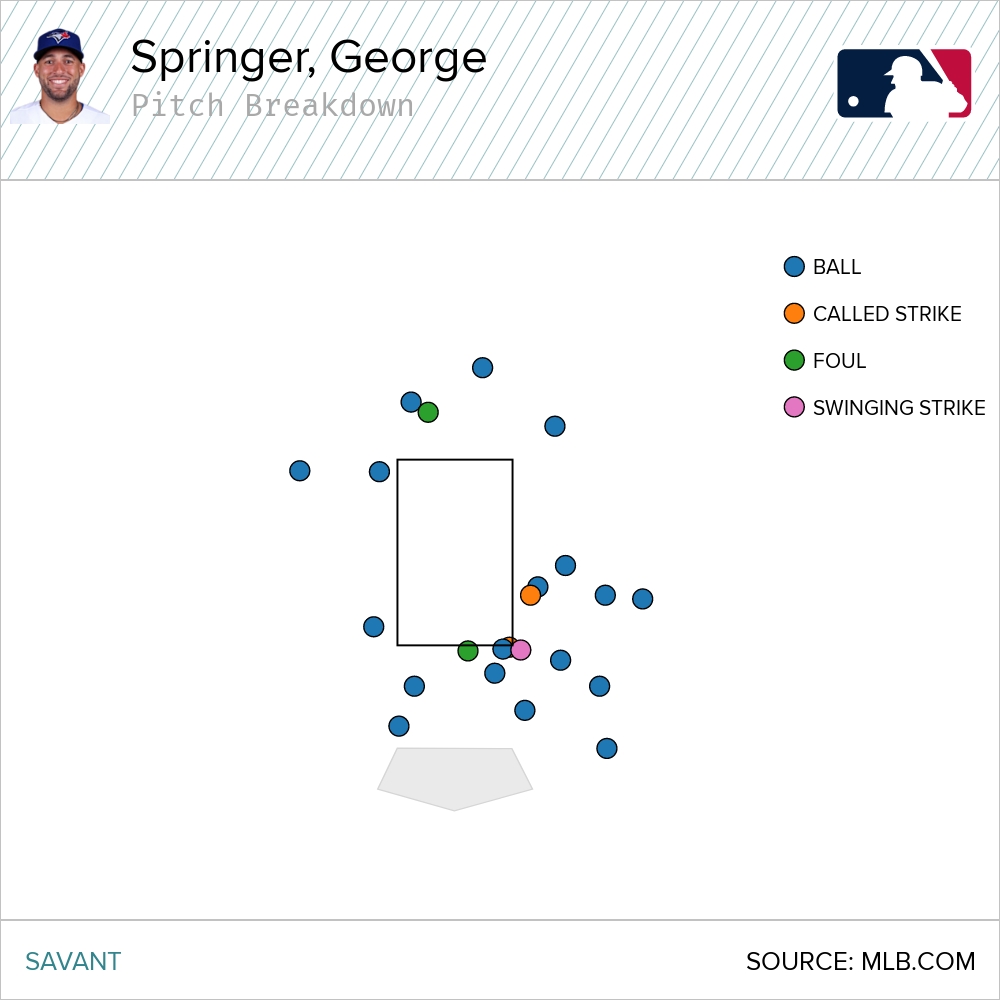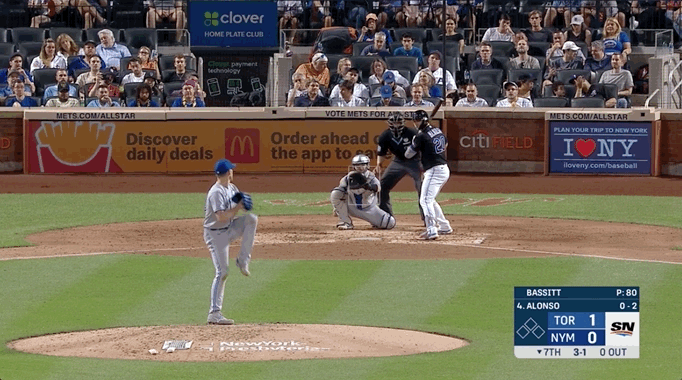NEW YORK — Just about everyone in the Toronto Blue Jays clubhouse has had their turn with the viral illness — illnesses, more likely — circulating amongst the team since spring training.
Players, coaches, staff. Alejandro Kirk battled it quietly during a recent road trip. Brandon Belt missed two games with it last week. At one point while playing the Tampa Bay Rays at Tropicana Field, John Schneider was managing without his pitching coach, Pete Walker, and bench coach, Dan Mattingly, who both had to duck out of the dugout mid-game.
“You’re around everyone for so long. Whether it’s plane, bus, clubhouse, dugout,” the Blue Jays manager said. “It’s been a little bit extreme. But I think guys are handling it the best they can.”
And yet, perhaps no one had it as bad as right-fielder George Springer. He picked the virus up in late April and suffered through it for several weeks, taking rounds of antibiotics and hits from oxygen canisters between innings. He sat out games in Boston and Philadelphia due to it. And even during the ones he started in between, coaches and teammates remarked at how amazed they were just to see him take the field.
“I’m not going to make an excuse for George,” Blue Jays starter Chris Bassitt said after an early-May outing in Pittsburgh. “But I’ve been surprised he played on a lot of the days that he’s been playing.”
It’s not the only explanation for Springer’s slow start this season — but it’s one of them. And recovering from that illness is undoubtedly a reason Springer has looked much more like himself of late. After picking up three hits this weekend against the Mets, Springer enters Monday’s play batting .321/.387/.536 with nine extra-base hits and nine walks to 11 strikeouts over the last three weeks. He’s had multiple hits in eight of his last 15 starts.

It’s been quite a turnaround for the Blue Jays' leadoff hitter, who began the second week of May batting .216/.278/.309 over his first 151 plate appearances of the season with only five extra-base hits. Strong contact-quality peripherals and expected numbers suggested Springer deserved better results than he’d seen. But those aren’t the numbers staring back at you from the centre-field videoboard as you step into the box to lead off a game.
“This is a game where everybody gets caught up in the numbers. But I don't. I like to look at the process. And I felt like I was having good at-bats early,” Springer says. “I just wasn't getting the results. And now I think the at-bats have been better. More quality. Not necessarily swinging as much. And I'm starting to get some results, which is always nice to see.”
A huge result came Friday, as Springer led off a ballgame against the Mets' Justin Verlander, took a fastball up-and-away, and unleashed on the very next pitch he saw, driving another heater 422-feet over the centre-field wall.
That was the only run Verlander allowed on a night he was featuring peak stuff and competitiveness, striking out eight over six innings on 117 pitches, while throwing seven of his eight hardest pitches on the night in a vintage, 28-pitch, empty-the-tank final frame.
“It’s not surprising. That’s who he is. As the game gets going, and the spots get bigger, he gets better. That’s standard for Justin Verlander,” said Springer, who knows the veteran right-hander well off the field from their time playing together with the Houston Astros. “Whenever you're facing a guy like him, you’ve got to be that much more locked in. And it's still not an easy task.
“The key is you’ve got to be ready to go. He's never going to back down. He's one of the best pitchers of our time. In my opinion, a Hall of Famer. And he's never going to quit. As an offence, you've got to be ready to hit. And if he makes a mistake, you better hit it.”
That sounds simple, but there’s a lot that goes into the mindset, preparation, and implementation of that approach. It’s what Springer’s been happiest about over his recent run of success at the plate. He feels he’s increased the quality of his plate appearances, making better swing decisions and executing more consistently on the game plans he carries into the batter’s box.
“Those are the things I look at rather than just pure numbers. The quality of contact. The amount of contact. Did I have a plan? Did I execute it?” Springer says. “If I did, I can't control what happens after the ball leaves my bat.”
Honing in on preparation and sticking to a patient approach was a theme for the Blue Jays up and down their lineup this weekend, as they swept the New York Mets. It extended a run that’s seen the Blue Jays post MLB’s lowest strikeout rate — 16.8 per cent — over the last 14 days.
Friday, they ran Verlander’s pitch count up and got him out of the game after six, making hay against the Mets bullpen with a couple late runs. Saturday, Vladimir Guerrero Jr. finally broke through in a big spot, lining a game-winning double into left field with two-out and two strikes in the ninth. Sunday, the Blue Jays handed Kodai Senga his worst start since making the jump to MLB, adjusting on the fly to the Japanese right-hander’s trademark ghost fork and laying off 10 of the 14 he threw.
“I would say that our at-bats as a group have been getting better over the last couple of series,” said Blue Jays third baseman Matt Chapman. “I know that throughout the course of the season, throughout your lineup there's going to be guys going through ups and downs. But if we can make even just tough outs and make guys work — even if you're not getting hits. Guys [Sunday] didn't get some hits, but they made [Senga] throw a lot of pitches, they didn't chase. I think those little things add up and lead to guys making mistakes and other guys doing damage.
“If we can grind down pitchers and make it really tough for them to get outs, it's going to be hard for us to go through highs and lows. That's how you find ways to win those close ballgames or one-nothing ballgames. You just grind guys down.”
That’s what Springer did Sunday, seeing 16 pitches across five plate appearances and putting three balls in play at 97-m.p.h. or harder. He made outs on balls with xBA’s of .410 and .670. — the latter of which would have been a home run at 16 MLB parks, including Rogers Centre. Of the 23 pitches he was thrown outside the zone throughout the Mets series, Springer swung at only three — two of them borderline.

That’s what Springer’s talking about. Focusing on the process numbers, not the outcome ones. And it’s not only his offensive production that’s rounding into form. It’s plays like this one — from Toronto’s 20-1 laugher against the Tampa Bay Rays on May 23 — that tell you Springer’s finally feeling like himself again:

Springer reached a sprint speed of 30.3 feet-per-second on that dash, his fastest sprint since in a calendar year. What would have happened if Springer tried to run like that when he was in the throes of his illness?
“Oh, I would have died,” Springer said. “When you’re sick, you just feel like you can’t do anything. So, it’s been nice to turn the page on that.”
He’s also back to making plays like these:

That’s Springer robbing Pete Alonso of a hit in the bottom of the seventh inning Friday — Chris Bassitt’s Dad Game. Springer was playing Alonso deep, as you ought to against a power hitter like him. And a lot of right fielders wouldn’t attempt to overcome that starting position, instead letting the ball drop and playing it on a bounce.
But as the ball came off Alonso’s bat, Springer considered the Mets first baseman’s lack of speed, how softly the ball was hit, and the game situation. It was all telling him to take a calculated risk. He figured he could contact the ball at the very least to keep it within a reasonable radius if he missed the catch — and possibly see it into his glove if he got on his horse.
“I have all that in mind. And if I have a good bead on it, I just have to go for it,” Springer said. “So, I went for it.”
Perhaps you’re sensing a theme. Preparation, mindset, execution. Process over results. These are the things Springer’s focused on amidst the difficult results he’s experienced so far this season. And they’re the reasons his numbers are creeping back up to where we’ve come to expect them to be.
“I think over the course of the year, I've just gradually gotten better. I'm not really putting any one thing on it. I know I had hit a lot of balls hard early that didn't fall. I just trust the process,” Springer says. “A lot of people like to put emphasis on numbers, which to me doesn't make sense. I get it. But, at the end of the day, I don't look at numbers. I just look at the process. And if I feel that the process is good, I know I'll be in a position to succeed eventually.”








COMMENTS
When submitting content, please abide by our submission guidelines, and avoid posting profanity, personal attacks or harassment. Should you violate our submissions guidelines, we reserve the right to remove your comments and block your account. Sportsnet reserves the right to close a story’s comment section at any time.